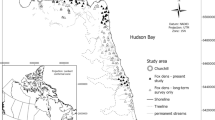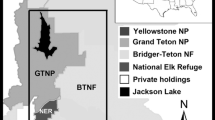Abstract
We examined 83 arctic fox (Alopex lagopus) dens on Bylot Island (Canada) during the summers of 2003–2005, to determine how arctic foxes select a denning site among potential sites, and a breeding den among existing dens. We compared denning sites to random locations in a 425 km2 study area (landscape scale) and to other potential denning sites in a 100 m radius (local scale). Dens were located on mounds or in slopes and were closer to streams than expected. Sites with low snow cover in spring, high ground temperature, high depth to permafrost, and steep and southerly exposed slopes were preferred. Of the 83 dens, 27 were used at least once for reproduction from 2003 to 2005. We show with a resource selection function analysis that an attractive force (distribution of food resources) and an apparently repulsive one (presence of other dens in the vicinity) affected selection of dens for reproduction. We generate testable hypotheses regarding the influence of food and social factors on the denning ecology of arctic foxes.





Similar content being viewed by others
References
Angerbjorn A, Hersteinsson P, Liden K, Nelson E (1994) Dietary variation in arctic foxes (Alopex lagopus)—an analysis of stable carbon isotopes. Oecologia 99:226–232
Angerbjorn A, Tannerfeldt M, Bjarvall A, Ericson M, From J, Noren E (1995) Dynamics of the arctic fox population in Sweden. Ann Zool Fenn 32:55–68
Angerbjorn A, Tannerfeldt M, Erlinge S (1999) Predator-prey relationships: arctic foxes and lemmings. J Anim Ecol 68:34–49
Anthony RM (1996) Den use by arctic foxes (Alopex lagopus) in a subarctic region of western Alaska. Can J Zool 74:627–631
Arjo WM, Bennett TJ, Kozlowski AJ (2003) Characteristics of current and historical kit fox (Vulpes macrotis) dens in the Great Basin Desert. Can J Zool 81:96–102
Bety J, Gauthier G, Giroux JF, Korpimaki E (2001) Are goose nesting success and lemming cycles linked? Interplay between nest density and predators. Oikos 93:388–400
Burnham KP, Anderson DR (2002) Model selection and multimodel inference: a practical information-theoretic approach, 2nd edn. Springer, New York
Chesemore DL (1969) Den ecology of the arctic fox in northern Alaska. Can J Zool 47:121–129
Chirkova AF (1968) The relationship between arctic fox and red fox in the far north. Probl North 11:111–113
Dalerum F, Tannerfeldt M, Elmhagen B, Becker D, Angerbjorn A (2002) Distribution, morphology and use of arctic fox Alopex lagopus dens in Sweden. Wildlife Biol 8:185–192
Duclos I, Lévesque E, Gratton D, Bordeleau PA (2006) Vegetation mapping of Bylot Island and Sirmilik National Park: final report. Parks Canada, Iqualuit
Eide NE, Jepsen JU, Prestrud P (2004) Spatial organization of reproductive arctic foxes Alopex lagopus: responses to changes in spatial and temporal availability of prey. J Anim Ecol 73:1056–1068
Eide NE, Nellemann C, Prestrud P (2001) Terrain structure and selection of denning areas by arctic foxes on Svalbard. Polar Biol 24:132–138
Garrott RA, Eberhardt LE, Hanson WC (1983) Arctic fox den identification and characteristics in northern Alaska. Can J Zool 61:423–426
Gauthier G, Pradel R, Menu S, Lebreton JD (2001) Seasonal survival of Greater Snow Geese and effect of hunting under dependence in sighting probability. Ecology 82:3105–3119
Gauthier G, Rochefort L, Reed A (1996) The exploitation of wetland ecosystems by herbivores on Bylot Island. Geosci Can 23:253–259
Gluyas J (2005) Sandstones, Diagenesis and porosity evolution. In: Selley RC, Cocks LRM, Plimer IR (eds) Encyclopedia of geology. Elsevier, Oxford, pp 141–151
Gruyer N (2007) Étude comparative de la démographie de deux espèces de lemmings (Lemmus sibericus et Dycrostonyx groelandicus) à l’Île Bylot, Nunavut, Canada. MSc Thesis, Université Laval, Québec
Hanley JA, McNeil BJ (1982) The meaning and use of the area under a receiver operating characteristic (ROC) curve. Radiology 143:29–36
Henner CM, Chamberlain MJ, Leopold BD, Burger LW (2004) A multi-resolution assessment of raccoon den selection. J Wild Manage 68:179–187
Hensher D, Johnson LW (1981) Applied discrete choice modeling. Croom Helm, London
Hooge PN, Eichenlaub W, Solomon E (1999) The animal movement program. USGS, Biological Science Center, Alaska
Hosmer D, Lemeshow S (2000) Applied logistic regression, 2nd edn. Wiley, New York, 373 pp
Kaikusalo A, Angerbjorn A (1995) The arctic fox population in Finnish Lapland during 30 years, 1964–93. Ann Zool Fenn 32:69–77
Killengreen ST, Ims RA, Yoccoz NG, Brathen KA, Henden J-A, Schott T (2007) Structural characteristics of a low arctic tundra ecosystem and the retreat of the arctic fox. Biol Conserv 135:569–472
Lepage D, Nettleship DN, Reed A (1998) Birds of Bylot Island and adjacent Baffin Island, northwest territories, Canada, 1979–1997. Arctic 51:125–141
Macpherson AH (1964) A northward range extension of the red fox in the eastern Canadian arctic. J Mammal 45:138–140
Macpherson AH (1969) The dynamics of Canadian arctic fox populations. Government of Canada, Ottawa
Manly BFJ, McDonald LL, Thomas DL (1993) Resource selection by animals: statistical design and analysis for field studies. Chapman and Hall, London, 177 pp
Marsh DB (1938) The influx of the red fox and its colour phases into the barren lands. Can Field Nat 52:60–61
Masse H, Rochefort L, Gauthier G (2001) Carrying capacity of wetland habitats used by breeding greater snow geese. J Wild Manage 65:271–281
Moehlmann PD (1989) Intraspecific variation in canid social systems. In: Gittlemann JL (ed) Carnivore behavior, ecology and evolution. Comstock Publishing Associates/Cornell University Press, Ithaca, pp 620
Negus NC, Berger PJ (1998) Reproductive strategies of Dicrostonyx groenlandicus and Lemmus sibiricus in high-arctic tundra. Can J Zool 76:391–400
Nellemann C, Fry G (1995) Quantitative-analysis of terrain ruggedness in reindeer winter grounds. Arctic 48:172–176
Nielsen SM, Pedersen V, Klitgaard BB (1994) Arctic fox (Alopex lagopus) dens in the Disko Bay area, west Greenland. Arctic 47:327–333
Pearce J, Ferrier S (2000) Evaluating the predictive performance of habitat models developed using logistic regression. Ecol Model 133:225–245
Predavec M, Krebs C J (2000) Microhabitat utilisation, home ranges, and movement patterns of the collared lemming (Dicrostonyx groenlandicus) in the central Canadian arctic. Can J Zool 78:1885–1880
Prestrud P (1992a) Denning and home-range characteristics of breeding arctic foxes in Svalbard. Can J Zool 70:1276–1283
Prestrud P (1992b) Physical characteristics of arctic fox (Alopex lagopus) dens in Svalbard. Arctic 45:154–158
Pruss SD (1999) Selection of natal dens by the swift fox (Vulpes velox) on the Canadian prairies. Can J Zool 77:646–652
Reed A, Hughes RJ, Boyd H (2002) Patterns of distribution and abundance of Greater Snow Geese on Bylot Island, Nunavut, Canada 1983–1998. Wildfowl 53:53–65
Rodgers AR, Lewis MC (1986) Diet selection in arctic lemmings (Lemmus sibiricus and Dicrostonyx groenlandicus): forage availability and natural diets. Can J Zool 64:1684–1689
Roth JD (2003) Variability in marine resources affects arctic fox population dynamics. J Anim Ecol 72:668–676
Ruggiero LF, Pearson DE, Henry SE (1998) Characteristics of American marten den sites in Wyoming. J Wild Manage 62:663–673
Slough BG (1999) Characteristics of Canada Lynx, Lynx canadensis, maternal dens and denning habitat. Can Field Nat 113:605–608
Seaman DE, Powell RA (1996) An evaluation of the accuracy of kernel density estimators for home range analysis. Ecology 77:2075–2085
Smits CMM, Smith CAS, Slough BG (1988) Physical characteristics of arctic fox (Alopex lagopus) dens in northern Yukon territory, Canada. Arctic 41:12–16
Steinberg D, Colla P (2004) Logistic Regression. In: (eds) SYSTAT® 11 Statistics. Richmond
Swanson DK (1996) Soil geomorphology on bedrock and colluvial terrain with permafrost in central Alaska, USA. Geoderma 71:157–172
Tannerfeldt M, Angerbjorn A (1998) Fluctuating resources and the evolution of litter size in the arctic fox. Oikos 83:545–559
Tannerfeldt M, Angerbjorn A, Arvidson B (1994) The effect of summer feeding on juvenile arctic fox survival—a field experiment. Ecograp 17:88–96
Tannerfeldt M, Moehrenschlager A, Angerbjorn A (2003) Den ecology of swift, kit and arctic foxes: a review. In: Sovada MA, Carbyn LN (eds) The swift fox: ecology and conservation in a changing world. Canadian plains research center, University of Regina, Saskatchewan, pp 167–181
Acknowledgments
We thank I. Klvana, P. Bergeron, M-A. Giroux, B. Tremblay, V. Careau, B. Laliberté, M. Morrissette, M. Graham-Sauvé, J. Pitseolak, G. Darou and S. Côté for their valuable assistance in the field, A. Caron for assistance in statistical and geospatial analysis, Sirmilik National Park of Canada for allowing us to work in the park, and E. Fuglei for her comments on an earlier draft of this manuscript. This study was supported by (alphabetical order): Canada Foundation for Innovation, Canada Research Chairs, Fonds Québécois de la Recherche sur la Nature et les Technologies, Mittimatalik Hunters and Trappers Organization, Natural Sciences and Engineering Research Council of Canada, Network of Centres of Excellence of Canada ArcticNet, Northern Ecosystem Initiative (Environment Canada), Northern Scientific Training Program (Indian and Northern Affairs Canada), Nunavut Wildlife Management Board, Parks Canada, Polar Continental Shelf Project, and Université du Québec à Rimouski. This is Polar Continental Shelf Project contribution no 037-07.
Author information
Authors and Affiliations
Corresponding author
Electronic supplementary material
Below is the link to the electronic supplementary material.
Rights and permissions
About this article
Cite this article
Szor, G., Berteaux, D. & Gauthier, G. Finding the right home: distribution of food resources and terrain characteristics influence selection of denning sites and reproductive dens in arctic foxes. Polar Biol 31, 351–362 (2008). https://doi.org/10.1007/s00300-007-0364-1
Received:
Revised:
Accepted:
Published:
Issue Date:
DOI: https://doi.org/10.1007/s00300-007-0364-1




